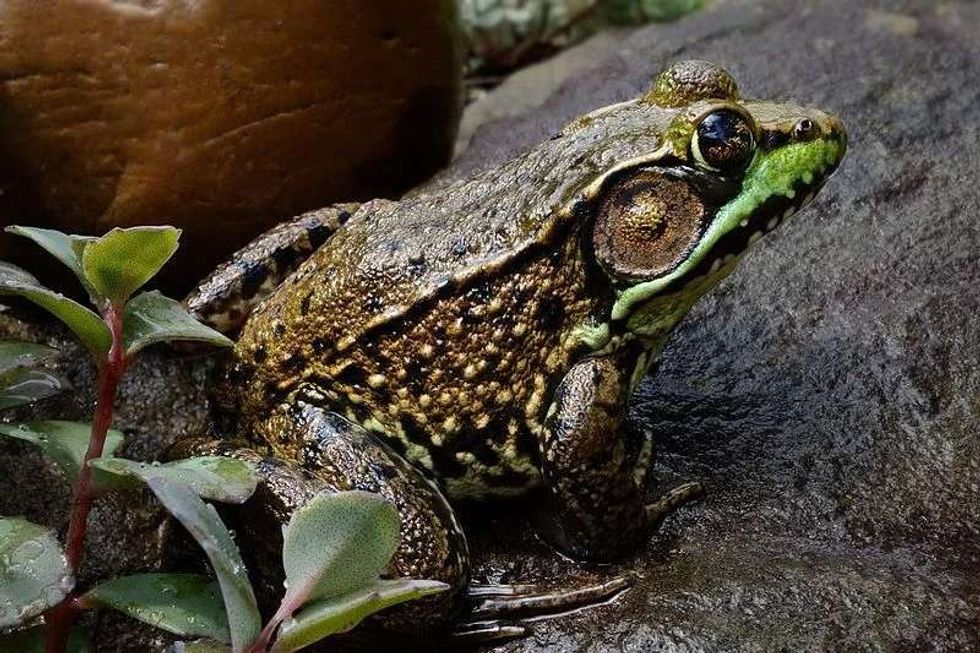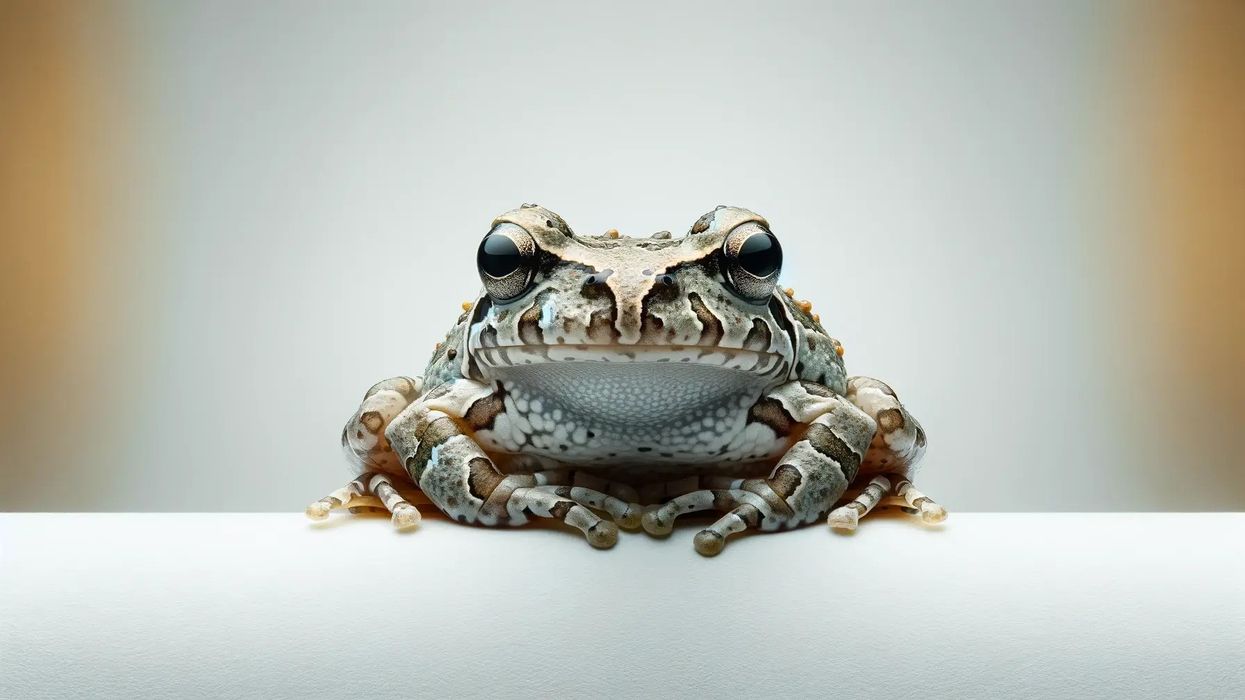The green frog (Lithobates clamitans) is a frog species native to eastern North America. Two subspecies of this frog are the bronze frog and the northern green frog.
One of the most common tadpoles native to the eastern countries and parts of Canada, they can be found just about everywhere there is a body of water for it to call home.
This animal is known for its rich green color, but this subspecies can include a different range of shades such as dark brown, bronze, even blue, with the bright yellow throat as they grow adult.
The green frog (Rana clamitans) are well-populated and not recognized imperiled despite rising pollution measures, that advance in its habitat. Their conservation status is of Least Concern as their population is stable.
These animals favor being alone but are known for meeting around breeding season. Green frogs (Rana clamitans) are also common pets due to their peaceful nature.
Their eggs or tadpoles become food for terrestrial predators, ranging from fish to water bugs and grackles. Eggs are laid on floating vegetation on the surface of the water. Males make a separate mating call that sounds like a sole banjo string being plucked.
Green frogs are the most common type used for green frog tadpoles leg dishes in the culinary world and scientific objectives. Their eardrums are profitable when it is time to mate. Males maintain a territory and use a diversity of calls to talk with other tadpoles.
Males use a particular call to attract females and to follow away competitive males. Keep reading to find out more!
For more relatable content, check out these black rain frog facts and ornate horned frog facts for kids.
Green Frog Interesting Facts
What type of animal is a green frog?
Green frogs are a type of aquatic frogs that are small animals.
What class of animal does a green frog belong to?
Green frogs belong to the class of Amphibia, from the phylum Chordate.
How many green frogs are there in the world?
The total population of these animals across the world is unknown.
Where does a green frog live?
Green frogs (Lithobates clamitans) are found in a wide range of habitats such as inland waters, including swamps, wooded swamps, lakes, marshes, bogs, banks of slow-moving rivers and streams, ponds, sloughs, and impoundments. They are found in regions including eastern North America, Canada, Florida, and wetland regions. Male green frogs may disperse into wooded areas when it rains.
What is a green frog's habitat?
Green frogs mostly live in inland waters, which include swamps, lakes, marshes, ponds, banks of slow-moving rivers and streams, sloughs, bogs, and impoundments. They can also be found in temperate terrestrial freshwater.
Who do green frogs live with?
Green frogs live a solitary life, even though sometimes they may appear in groups near ponds or lakes. They can be found in shallow freshwater ponds, roadside ditches, lakes, swamps, streams, and rooks.
How long does a green frog live?
On average, green true frogs can live up to six years.
How do they reproduce?
Female green frogs (Rana clamitans) pick their partners based on the worth of their territories for egg-laying. Green frogs breed generally between April to August.
Asteroid males may also be present during the breeding season of green frogs. An asteroid male green frogs are defined as smaller male green frogs, helpless to take and defend territories, and it is often seen in areas protected by a larger male.
Asteroid male green frogs wait for the chance to mate with a female green frog that reacts to larger more powerful males vocalizations. The reproductive process is recognized as 'amplexus' and consists of male green frogs grasping a female green frog back and fertilizing externally.
Females first produce the egg internally where they are fed before delivering them. This process leaves the frogs weak to predators as they are easy prey. Eggs are presented in clutches of a wide range of sizes.
Most clutches carry at least 1,000 eggs. The eggs may be connected to aquatic vegetation but often easily float to the water surface making them easy targets for possible predators.
Luckily, most eggs are ready in less than a week. Adults green frogs do not worry for their young, making them weak to different aquatic and ground predators.
Green frogs start visiting in late spring to mid-summer and may breed as late as August. Small clutches of eggs are displayed over immersed vegetation in hard water.
Tadpoles remain whole winter in water before modifying the following summer. Because of the long breeding season and extended larval stage, tadpoles of different sizes and recently transformed frogs can be obtained during spring and summer.
Once the eggs have been produced, the tadpole stage of growth begins. This season of growth typically lasts up to two years after which they turn into adult frogs.
True frogs adult can live up to 10 years in captivity, but most are located in the wildlife for six years or less. Due to the green frog (Rana clamitans) long lifespan and easy nature, these species are popular pets that are comparatively easy to care for.
What is their conservation status?
The conservation status of the green frog (Rana clamitans) is Least Concern.
Green Frog Fun Facts
What do green frogs look like?
Green frogs are green in color but appear in a wide range of colors. A rare handful of them have blue skin.
They can usually be identified by their appearance of brighter in front with random small black points. Green frog (Lithobates clamitans) legs have dark lines across them, and their skin is yellowish or white below the spots.
Males usually have a bright yellow throat. The green frog (Rana clamitans) tympanum (with an external ear on the side of their heads) is big.
It may be green, brown, bronze, or mixture but typically green on the upper lip. The stomach is white with a dark line or dot. There may be some unusual spotting on the back.
It is divided into species of frogs in that the dorsolateral crests run only partially down the back and do not give the groin. The tympanum is much bigger than the eye in males and is similar in size to the eye in a female green frog.
Green frogs, Rana clamitans, have a well-defined back backbone that extends from the back of the eye and maintains the length of their body. The green frog skin tone is well webbed, and their first fingers do not extend beyond their other finger.
Their body length is around 2-4 in (5-10 cm), with an average weight of 1-3 oz (28.3-85 g). They are physically similar to the northern green frog.

How cute are they?
These amphibians are not cute as they have a slimy, poisonous look, even though they may not have poison in themselves. However, a few people keep them as pets as they find it amusing, and mostly due to their friendly nature.
How do green frogs communicate?
Males defend their territory and use a diversity of calls to communicate with other tadpoles. These male green frog (tadpoles) uses a specific call to seduce females, follow away competitive males, and more.
How big are green frogs?
They have a body length of around 2-4 in (5-10 cm), which is five times bigger than a desert rain frog.
How fast can a green frog move?
This frog species can travel up to 10 mph (16 kph). Their moving speed is more than other small frogs in general.
How much does a green frog weigh?
They weigh around 1-3 oz (28.3-85 g). Male green frogs are slightly smaller than female green frogs.
What are the male and female names of the species?
There are no specific names to describe the male and female of true frogs.
What would you call a baby green frog?
The young of this frog is known as a tadpole.
What do green frogs eat?
Green frogs are essentially carnivores and eat a wide range of insects from both land and shallow water like slugs, snails, crayfish, spiders, flies, caterpillars, butterflies, and moths. They will also eat other vegetation and animals, such as small snakes and frogs as food.
Are they poisonous?
No, green frogs (Clamitans melanota) are not poisonous. You must not confuse them with green tree frogs which are known for being poisonous. However, they are not highly poisonous for humans.
Would they make a good pet?
Green frogs, Lithobates clamitans, are wonderful pets. Even wild-caught adults can settle down and can be hand-fed in a short time. This is in sharp contrast to several American frog natives, including American bullfrogs, leopard frogs, and pickerel frogs, which often remain high-strung and difficult to observe, even after years in captivity.
Did you know...
The green frog is called Lithobates clamitans or Rana clamitans.
The northern green frog (Rana clamitans) is a subspecies of the green frog. These tadpoles need easy and consistent food origins as they follow awaiting procedure that needs minimum movement on their part.
While fishing, they favor sitting and calmly wait for possible prey to get near enough for them to take the other animals with their tongue.
Male frogs are known for exhibiting destructive behavior when it grows to find a partner. They often complain to other males by sending a warning in different energy levels before trying to attack.
These frogs are found both in the daytime and night. During the colder months, they dig holes and vegetate underground. After they appear in the spring, they meet in large numbers to breed.
Male green frogs use their calls to attract the females. You can find this species of frog from the southern reaches of eastern Canada to northern Florida.
In the westernmost area of their range, these animals extend from Canada through Minnesota and south to Texas. The north subspecies live throughout the northeast. The bronze subspecies occupy the south state from Texas to southern North Carolina.
How many eggs do green frogs lay?
Green frogs species breed in the late spring season and can lay up to 4,000 eggs per season. Eggs prepare in three to five days and complete the tadpole stage of development in 3-22 months. The green frog, Rana clamitans, can have two or more breeding per season, with the second coupling producing significantly fewer eggs.
How to care for green frogs
Some terrariums and aquariums keep these green frogs in their groups. Like amphibians, they make excellent representatives for the delicate state of the sea ecosystems that they live in the sea. As pets, you must put these animals in almost large enclosures with controlled moisture and a freshwater source, and serve them commercially provided food for amphibians, and minnows.
Here at Kidadl, we have carefully created lots of interesting family-friendly animal facts for everyone to discover! Learn more about some other amphibians from our American toad interesting facts and bullfrog surprising facts pages.
You can even occupy yourself at home by coloring in one of our free printable Green frog coloring pages.









